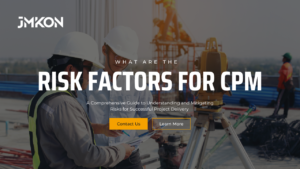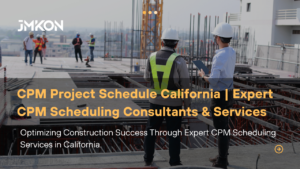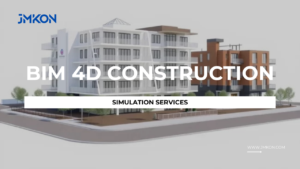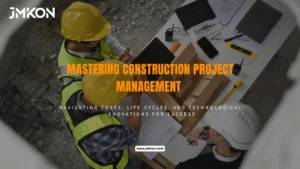Construction Project Management strategies are the backbone of successful projects, ensuring every phase—from planning to execution—is handled with precision and efficiency. They provide a structured approach to managing the intricate challenges of the construction industry, where tight schedules, fluctuating resources, and unexpected risks are part of daily operations.
What makes construction project management uniquely complex is its multidimensional nature. Each project involves coordinating diverse teams, managing resources effectively, and mitigating risks that can disrupt progress. Without the right strategies in place, even the best-laid plans can falter, leading to delays, cost overruns, or compromised quality.
In this article ,article, we’ll uncover proven strategies to simplify complexity, boost efficiency, and achieve measurable results in construction projects. From addressing risks to aligning goals with strategic objectives, you’ll gain insights to elevate your approach and navigate the most demanding projects with confidence.
Effective Construction Management Strategies
Managing risks effectively is at the heart of successful Construction Project Management strategies, as risks are inevitable in any construction project. From unexpected delays to financial constraints, proactively identifying and addressing potential risks during the planning phase can make the difference between a smoothly executed project and one riddled with setbacks.
Identifying Potential Risks
Every construction project begins with uncertainty, but identifying potential risks early can prevent costly surprises down the line. Proactive risk identification during the planning phase allows project managers to foresee obstacles and devise Construction Project Management strategies before they escalate.
Common risks in construction include:
- Weather-related delays: Sudden storms or extreme temperatures can disrupt schedules.
- Resource shortages: Material or labor unavailability can halt progress.
- Design errors or scope changes: Misalignments in plans lead to rework, inflating costs and time.
- Regulatory and compliance challenges: Missing permits or overlooked legal requirements can result in fines or project shutdowns.
Mitigation Strategies for Construction Risks

Mitigation begins with preparation. Employing robust Construction Project Management strategies ensures risks are managed effectively rather than reacted to after the fact.
- Contingency Planning:
- Allocating buffer resources (time, budget, and materials) allows flexibility to address unforeseen issues.
- Create alternative plans to address high-priority risks, ensuring the project stays on track.
- Real-Time Monitoring:
- Use live data to track project progress and spot risks as they arise. Early detection allows quick interventions to minimize disruptions.
- Team Collaboration:
- Foster open communication among all stakeholders, ensuring everyone is aware of potential risks and their roles in mitigating them.
- Conduct regular risk review meetings to reassess evolving challenges and refine mitigation plans.
Leveraging Technology for Risk Management
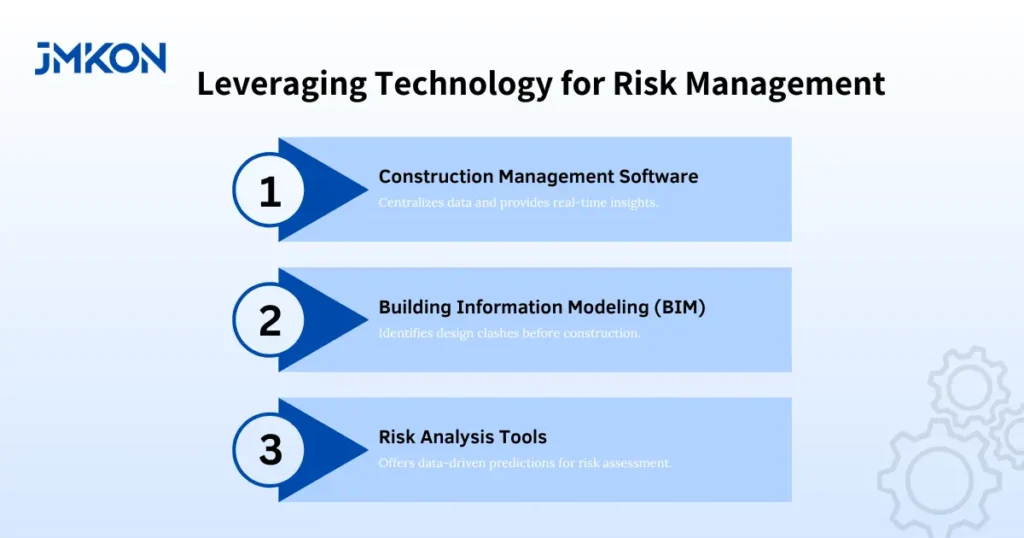
Technology has become a cornerstone of risk management in construction projects, offering powerful tools to track, analyze, and minimize risks effectively.
- Construction Project Management Software:
Tools like Primavera, Procore and PlanGrid cloud-based Construction Project Management softwares help project managers centralize data, providing real-time insights into progress and potential risks. - Building Information Modeling (BIM):
BIM technology aids in identifying design clashes and logistical issues before construction begins, reducing the likelihood of costly mistakes. - Risk Analysis Tools:
Software such as Primavera Risk Analysis offers data-driven predictions to assess risk impact and optimize project schedules accordingly.
Comprehensive Resource Management in Construction Projects
Efficient resource management is a cornerstone of effective Construction Project Management strategies. Balancing labor, equipment, and materials ensures that projects remain on track, within budget, and aligned with quality expectations. Mismanagement of resources often leads to delays, wasted costs, and strained relationships with stakeholders. This section explores practical approaches to optimizing resource use and maintaining project efficiency.
Strategic Allocation of Resources
Balancing labor, equipment, and materials is critical for maximizing project efficiency. Strategic allocation begins with understanding the specific needs of a project and ensuring the right resources are available at the right time.
Key approaches include:
- Labor Management: Assigning tasks based on skillsets and availability prevents bottlenecks. For example, critical tasks should be handled by specialized professionals, while general tasks can be allocated to broader teams.
- Equipment Optimization: Scheduling equipment usage reduces idle times and ensures machinery is neither overused nor underutilized.
- Material Planning: Stockpiling materials may seem like a safeguard, but overstocking increases storage costs and risks of damage. Instead, align procurement schedules with project timelines.
Managing Constraints to Prevent Delays
Construction projects often face resource constraints, including budgetary limits, labor shortages, or unforeseen supply chain disruptions. Effective resource management can mitigate these challenges and keep projects moving forward.
Real-world challenges:
- Labor Shortages: Unexpected worker absences can slow down critical tasks.
- Solution: Maintain a flexible workforce by cross-training employees and maintaining relationships with staffing agencies.
- Equipment Breakdowns: Machinery failure can halt progress on site.
- Solution: Schedule regular maintenance and keep backup equipment available.
- Material Delays: Late deliveries can derail timelines.
- Solution: Build relationships with multiple suppliers and incorporate buffer time in procurement schedules.
Tracking Resource Utilization
Modern technology has revolutionized resource management in construction projects, making it easier to monitor and optimize resource use in real time.
Building Information Modeling (BIM):
BIM technology enhances visibility by providing a detailed 3D representation of the project, including precise quantities of materials and schedules for labor and equipment use. This reduces waste, avoids clashes, and ensures efficient deployment of resources.
Detailed Reporting Tools:
Construction Project management software like Oracle Primavera Procore or Oracle Primavera generates comprehensive reports that highlight resource utilization patterns. These reports allow project managers to:
- Identify inefficiencies and adjust resource allocation proactively.
- Forecast future needs based on real-time data.
- Make informed decisions that save time and costs while maintaining quality.
Best Strategy for Your Construction Company
For construction companies, no single strategy fits all projects. Success lies in implementing well-thought-out Construction Project Management strategies tailored to the specific demands of each project. From residential developments to large-scale infrastructure initiatives, adapting your approach ensures projects are delivered on time, within scope, and to the highest quality standards.
Customized Strategies for Each Project

The type and complexity of a construction project significantly influence the strategies required to manage it effectively. Tailoring construction management strategies ensures that resources are used efficiently and project risks are mitigated.
Key considerations by project type:
- Residential Projects: These projects often require streamlined workflows to minimize disruptions to the surrounding community. Strategies include careful scheduling to ensure timely delivery and clear communication with homeowners or developers.
- Commercial Projects: With tighter deadlines and higher stakeholder expectations, commercial projects demand precise resource management and proactive risk mitigation. Using tools like BIM can help identify potential design clashes early.
- Infrastructure Projects: Large-scale infrastructure projects involve extensive coordination across multiple teams and contractors. Construction management strategies include rigorous risk assessments and leveraging advanced scheduling tools to ensure alignment between phases.
Enhancing Communication Channels
Effective communication is the backbone of any successful project. Misalignment between stakeholders, such as clients, contractors, and team members, can lead to costly errors and delays. Establishing clear communication channels minimizes misunderstandings and fosters collaboration.
How to improve communication:
- Use centralized platforms like Procore or Slack to ensure all stakeholders have access to updated project details.
- Schedule regular progress meetings to align goals, review milestones, and address challenges.
- Encourage an open feedback loop where all team members feel empowered to share insights or raise concerns.
JMKON’s Role in Crafting Winning Strategies
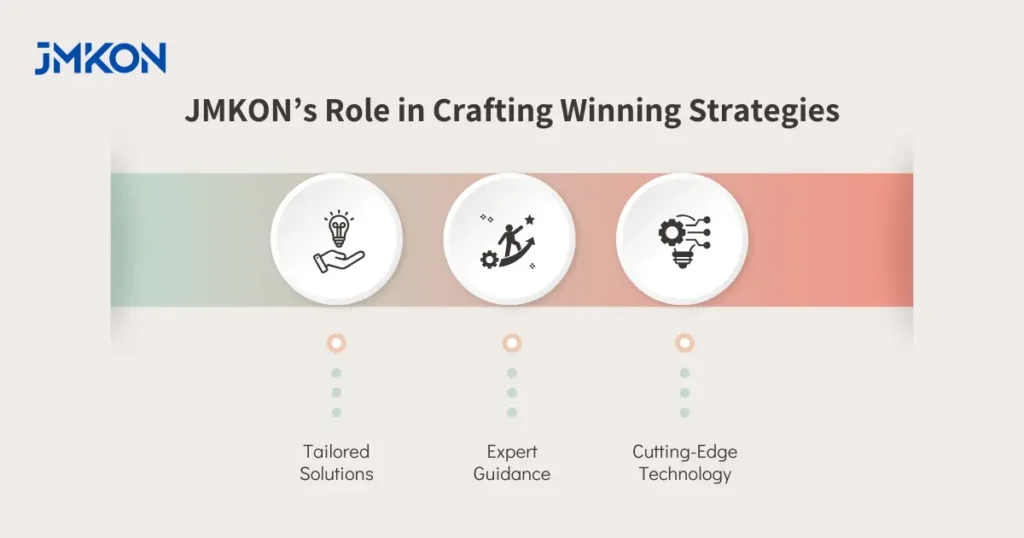
At JMKON, we understand that every construction project is unique, requiring a personalized approach to management. Our expertise spans a wide range of services, including resource management in construction projects, risk assessment, and project scheduling.
Here’s how JMKON helps construction companies succeed:
- Tailored Solutions: We analyze your project’s specific requirements and develop customized construction management strategies that align with your goals.
- Expert Guidance: Our team of experienced professionals ensures that risks are mitigated, resources are optimized, and timelines are met.
- Cutting-Edge Technology: By leveraging advanced tools like BIM Modeling and scheduling software, we enhance efficiency and reduce project complexities.
Aligning Project Goals with the Company’s Strategic Objectives
Successful Construction Project Management companies recognize that each project contributes to their overall growth and reputation. Aligning individual project goals with broader strategic objectives ensures that every effort moves the company closer to its long-term vision. This requires clear planning, constant monitoring, and a willingness to adapt as circumstances evolve.
Defining Clear Objectives for Each Project
The foundation of aligning project goals with company objectives lies in strategic planning. Every project should be approached with a clear understanding of how its success impacts the company’s larger goals, such as profitability, client satisfaction, or market expansion.
Steps to achieve alignment:
- Identify Overarching Objectives: Start by outlining the company’s strategic priorities, such as entering new markets, improving operational efficiency, or enhancing sustainability practices.
- Translate Objectives to Projects: Define how each project can contribute to these priorities. For instance, a residential development may focus on improving client satisfaction by delivering ahead of schedule, while an infrastructure project might prioritize cost efficiency to maximize profit margins.
- Set Measurable Goals: Establish specific, actionable goals for the project, such as meeting a target completion date, adhering to a predefined budget, or achieving certain quality benchmarks.
Monitoring and Adjusting Goals During Execution
Even the best-laid plans can face unexpected changes during execution. Periodic reviews are essential for ensuring projects remain aligned with broader business objectives while adapting to new challenges.
Examples of goal monitoring:
- Resource Allocation Reviews: Regularly assess whether labor, equipment, and materials are being utilized efficiently to meet project milestones.
- Client Feedback: Incorporate client input at key stages to ensure their expectations align with the company’s goals for quality and delivery.
Role of Key Performance Indicators (KPIs):
Tracking KPIs provides a data-driven way to evaluate progress and make adjustments. Common construction project KPIs include:
- Schedule Adherence: Measures whether tasks are being completed on time.
- Budget Variance: Tracks how closely actual spending aligns with the budget.
- Quality Metrics: Assesses compliance with safety standards or quality benchmarks.
Scheduling Software for Construction Project Management
Scheduling software has revolutionized the construction industry by enabling more precise planning, real-time updates, and enhanced communication. As a core element of modern Construction Project Management strategies, these tools provide the efficiency and accuracy needed to tackle complex projects while keeping timelines and budgets on track.
a. Advantages of Scheduling Software
Scheduling tools like Primavera P6 and Microsoft Project are essential for improving time management and ensuring project milestones are achieved without delays.
Key advantages include:
- Time-Saving: These tools automate tedious scheduling tasks, freeing up project managers to focus on decision-making and problem-solving. For instance, they allow for quick adjustments to schedules when delays or changes occur.
- Task Prioritization: Advanced algorithms help prioritize tasks based on dependencies, ensuring critical activities are completed first and reducing the risk of bottlenecks.
- Deadline Adherence: By visualizing project timelines through Gantt charts or CPM analysis, teams can track progress in real time and identify delays early.
Automating Scheduling to Reduce Errors
Manual scheduling is prone to human error, leading to oversights that can derail projects. Automation features in modern scheduling tools help minimize these risks while streamlining processes.
Examples of automation benefits:
- Dynamic Scheduling: Automatically adjusts timelines when changes are made, ensuring that all dependencies and resource allocations are updated in real time.
- Conflict Resolution: Flags potential clashes, such as overlapping resource assignments or unrealistic deadlines, before they become critical issues.
- Progress Tracking: Real-time data collection automates reporting on project milestones, reducing the chance of errors in manual updates.
JMKON’s Expertise in Project Scheduling
At JMKON for Construction Management, we understand that efficient scheduling is the backbone of successful construction project management. Our team leverages industry-leading tools like Primavera P6, Microsoft Project, and other cutting-edge software to optimize schedules, minimize risks, and achieve seamless project execution.
How JMKON delivers results:
- Tailored Scheduling Solutions: We create customized schedules that align with your project’s unique requirements, ensuring that all activities are logically sequenced and resources are allocated effectively.
- Real-Time Adjustments: JMKON’s experts use scheduling software to provide real-time updates and adapt to changes, ensuring projects remain on track.
- Precision and Efficiency: By utilizing advanced features such as CPM analysis and automation, we reduce the likelihood of delays and keep projects aligned with deadlines and budgets.
At JMKON, we specialize in providing tailored solutions and Construction Project Management strategies that align with the unique needs of each project, helping you overcome challenges and deliver exceptional outcomes. Whether you’re working on a residential, commercial, or large-scale infrastructure project, we have the expertise and tools to support you every step of the way.
Contact Us
Make a Call
- New York: (646) 847-1100
- Texas: (214) 306-5834
- California: (213) 293-4140
Address
- 105 West 125th #1408, New York, NY 10027
- 1942 W Gray St #1184, Houston, TX 77019
- 3680 Wilshire Blvd Ste P04 – 1138, Los Angeles, CA 9001
Send a Mail
info@jmkon.com
Get in touch with us today to learn how we can help you optimize your construction project management and drive success across all your initiatives.

